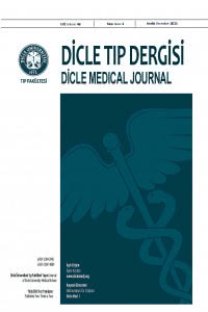Comparison of the Analgesic Effects of Ultrasound Guided Pectoral Nerve Block Type II and Erector Spinae Plane Block in Breast Cancer Surgery
Breast surgery, Erector Spinae Plane Block, Pain management, Pectoral Nerve Block 2, Breast surgery, Erector Spinae Plane Block, Pain management, Pectoral Nerve Block 2
Comparison of the Analgesic Effects of Ultrasound Guided Pectoral Nerve Block Type II and Erector Spinae Plane Block in Breast Cancer Surgery
___
- 1. Siegel RL, Miller KD, Jemal A. Cancer statistics, 2016. CA Cancer J Clin. 2016; 66: 7-30.
- 2. Çiftci F, TolgaKafadar M. The Role Of Breast- Conserving Surgery In The Treatment Of Early-Stage Breast Cancer. Dicle Med J. 2020; 47: 852-8.
- 3. Vadivelu N, Schreck M, Lopez PAJ, Kodumudi G, Narayan D. Pain after mastectomy and breast reconstruction. Am Surg. 2008; 74: 285-96.
- 4. Hussain N, Brull R, McCartney CJL, et al. Pectoralis- II Myofascial Block and Analgesia in Breast Cancer Surgery: A Systematic Review and Meta-analysis. Anesthesiology. 2019; 131: 630-48.
- 5. Blanco R, Fajardo M, Parras Maldonado T. Ultrasound description of Pecs II (modified Pecs I): A novel approach to breast surgery. Rev EspAnestesiolReanim. 2012; 59(9): 470-5.
- 6. Aksu C, Kuş A, Yörükoğlu HU, Tor Kiliç C, Gürkan Y. Analgesic effect of the bi-level injection erector spinae plane block after breast surgery: A randomized controlled trial. Agri. 2019; 31: 132-7.
- 7. He W, Wu Z, Zu L, Sun H, Yang X. Application of erector spinae plane block guided by ultrasound for postoperative analgesia in breast cancer surgery: A randomized controlled trial. Cancer Commun. 2020; 40: 122-25.
- 8. Chin KJ, Adhikary S, Sarwani N, Forero M. The analgesic efficacy of pre-operative bilateral erector spinae plane (ESP) blocks in patients having ventral hernia repair. Anaesthesia. 2017; 72: 452-60.
- 9. Gürkan Y, Aksu C, Kuş A, Yörükoğlu UH, Kılıç CT. Ultrasound guided erector spinae plane block reduces postoperative opioid consumption following breast surgery: A randomized controlled study. J ClinAnesth. 2018; 50(June): 65-8.
- 10. Altıparmak B, KorkmazToker M, Uysal Aİ, Turan M, GümüşDemirbilek S. Comparison of the effects of modified pectoral nerve block and erector spinae plane block on postoperative opioid consumption and pain scores of patients after radical mastectomy surgery: A prospective, randomized, controlled trial. J ClinAnesth. 2019; 54: 61-5.
- 11. Gad M, Abdelwahab K, Abdallah A, Abdelkhalek M, Abdelaziz M. Ultrasound-guided erector spinae plane block compared to modified pectoral plane block for modified radical mastectomy operations. Anesth Essays Res. 2019; 13: 334.
- 12. Hussain N, Shastri U, McCartney CJL, et al. Should Thoracic Paravertebral Blocks Be Used to Prevent Chronic Postsurgical Pain after Breast Cancer Surgery? A Systematic Analysis of Evidence in Light of IMMPACT Recommendations. Pain. 2018; 159: 1955-71.
- 13. Ohgoshi Y, Ikeda T, Kurahashi K. Continuous erector spinae plane block provides effective perioperative analgesia for breast reconstruction using tissue expanders: A report of two cases. J ClinAnesth. 2018; 44: 1-2.
- 14. Chiu C, Aleshi P, Esserman LJ, et al. Improved analgesia and reduced post-operative nausea and vomiting after implementation of an enhanced recovery after surgery (ERAS) pathway for total mastectomy. BMC Anesthesiol. 2018; 18: 41.
- 15. Sinha C, Kumar A, Kumar A, et al. Pectoral nerve versus erector spinae block for breast surgeries: A randomised controlled trial. Indian J Anaesth. 2019; 63: 617.
- 16. Thomas M, Philip FA, Mathew AP, Jagathnath Krishna KM. Intraoperative pectoral nerve block (Pec) for breast cancer surgery: A randomized controlled trial. J AnaesthesiolClinPharmacol. 2018; 34: 318-23.
- 17. Kulhari S, Bharti N, Bala I, Arora S, Singh G. Efficacy of pectoral nerve block versus thoracic paravertebral block for postoperative analgesia after radical mastectomy: A randomized controlled trial. Br J Anaesth. 2016; 117: 382-86.
- 18. Veiga M, Costa D, y IB-RE de A. Erector spinae plane block for radical mastectomy: a new indication. Elsevier. 2018; 65: 112-5.
- 19. Adhikary S Das, Bernard S, Lopez H, Chin KJ. Erector Spinae Plane Block Versus Retrolaminar Block: A Magnetic Resonance Imaging and Anatomical Study. RegAnesth Pain Med. 2018; 43: 756-62.
- 20. Kim DH, Kim S, Kim CS, et al. Efficacy of pectoral nerve block Type II for breast-conserving surgery and sentinel lymph node biopsy: A prospective randomized controlled study. Pain Res Manag. 2018.
- 21. Versyck B, van Geffen GJ, Van Houwe P. Prospective double blind randomized placebocontrolled clinical trial of the pectoral nerves (Pecs) block type II. J ClinAnesth. 2017; 40: 46-50.
- 22. Helander EM, Webb MP, Kendrick J, et al. PECS, serratus plane, erector spinae, and paravertebral blocks: A comprehensive review. Best Pract Res ClinAnaesthesiol. 2019; 33: 573-81.
- 23. Bakshi SG, Karan N, Parmar V. Pectoralis block for breast surgery: A surgical concern? Indian J Anaesth. 2017; 61: 851-52.
- 24. Andersen KG, Kehlet H. Persistent pain after breast cancer treatment: A critical review of risk factors and strategies for prevention. J Pain. 2011; 12: 725-46.
- 25. De Cassai A, Bonanno C, Sandei L, et al. PECS II block is associated with lower incidence of chronic pain after breast surgery. Korean J Pain. 2019; 32: 286-91.
- ISSN: 1300-2945
- Yayın Aralığı: 4
- Başlangıç: 1963
- Yayıncı: Cahfer GÜLOĞLU
Selin KOÇ, Engin RAMAZANOĞLU, Burcu TALU
Graves hastalığı cerrahisinde güncel yaklaşımlar
Sigara İçiminin Gastrik Miyoelektrik Aktiviteye Etkisinin Araştırılması
Hamza KAYA, Hüda OFLAZOĞLU DİKEN, Hacer KAYHAN KAYA, Mustafa KELLE, Cemre UÇAR EKİN
Comparison of Effects of Ketamine, Esmolol and Lidocaine on Propofol Injection Pain
Döndü Genç MORALAR, Aygen Ülkü TÜRKMEN, Aysel Hatice ALTAN
Burhan ASLAN, Ümit İNCİ, Ferhat IŞIK, Mehmet Zülküf KARAHAN, Murat ÇAP, İsmail TATLI, Bedrettin BOYRAZ, Metin OKŞUL
Hamza AKTAŞ, Zeynep ŞENER BAHÇE, Ebral YİĞİT
Remzi SARIKAYA, Ömer KÜMET, Berat ENGİN, Ömer ŞİT, Cafer PANÇ, Onur ERDOĞAN, Hüseyin OFLAZ
Fibrinogen to Albumin Ratio Predicts Burden of Coronary Artery Disease in Patients with NSTEMI
Muhammed DEMİR, Mehmet ÖZBEK, Adem AKTAN, Faruk ERTAŞ
Seyhmus KÜLAHCİOGLU, Murat KARACAM, Nesri DANISMAN, Seref Berk TUNCER, Barkın KÜLTÜRSAY, Ali Furkan TEKATLİ, Ayhan TOSUN, Ravza Betül AKBAS, Ayhan KÜP, Mehmet AYTÜRK, Ender Özgün ÇAKMAK, Abdülkadir USLU
